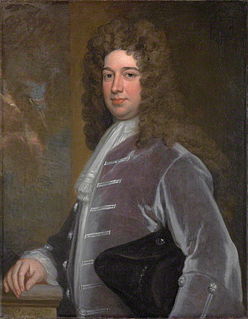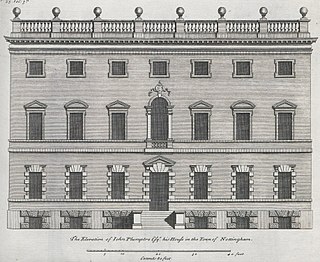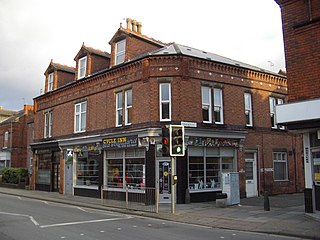
Evelyn Pierrepont, 1st Duke of Kingston-upon-Hull, was an English aristocrat, the third son of Robert Pierrepont of Thoresby, Nottinghamshire, and his wife Elizabeth Evelyn, and the grandson of William Pierrepont of Thoresby. He was born at West Dean, Wiltshire.

Earl Manvers was a title in the Peerage of the United Kingdom. It was created in 1806 for Charles Medows Pierrepont, 1st Viscount Newark. He had already been created Baron Pierrepont, of Holme Pierrepont in the County of Nottingham, and Viscount Newark, of Newark-on-Trent in the County of Nottingham, in 1796. Both these titles were in the Peerage of Great Britain. Born Charles Medows, he was the second son of Philip Medows, Deputy Ranger of Richmond Park, by Lady Frances Pierrepont, daughter of William Pierrepont, Earl of Kingston (1692–1713), eldest son and heir apparent of Evelyn Pierrepont, 1st Duke of Kingston-upon-Hull. The name of the earldom derives from the Manvers family, from a marriage to an heiress of which family the family seat of Holme Pierrepont had passed into the Pierrepont family in the 13th century.
Colwick is a village, civil parish, and suburb of the city of Nottingham, in the English ceremonial county of Nottinghamshire. It is situated to the east of Nottingham's city boundary, and forms the Colwick ward within the local government district of Gedling. At the time of the 2011 census, the village had a population of 2,829.

Radcliffe-on-Trent is a large village and civil parish in the Rushcliffe borough of Nottinghamshire, England. The population of the civil parish at the Census 2011 was 8,205.

Lady Bay is an area adjacent to West Bridgford, in Nottinghamshire, England, bounded by the River Trent to the north and the Grantham Canal to the south. It is within 2 miles of the centre of Nottingham, but is more suburban/semi-rural in its character.

Middleton Stoney is a village and civil parish about 2+1⁄2 miles (4 km) west of Bicester, Oxfordshire. The 2011 Census recorded the parish's population as 331. The parish measures about 2 miles (3 km) north–south and about 1+1⁄2 miles (2.4 km) east–west, and in 1959 its area was 1,853 acres (750 ha). Its eastern boundary is Gagle Brook, a tributary of the River Ray, and its western boundary is Aves ditch. It is bounded to the north and south by field boundaries.
Nottinghamshire was a county constituency of the House of Commons of the Parliament of England then of the Parliament of Great Britain from 1707 to 1800 and of the Parliament of the United Kingdom from 1801 to 1832. It was represented by two Members of Parliament (MPs), traditionally known as Knights of the Shire.

This article is about the history of Nottingham.

Thomas Chambers Hine was an architect based in Nottingham.

The Adams Building, formerly the Adams and Page warehouse on Stoney Street, is the largest building in the Lace Market district of the city of Nottingham in England.

Battlefield House near King Street East and Centennial Parkway in Stoney Creek, Hamilton, Ontario, Canada is a living history museum and site of the historic Battle of Stoney Creek on June 6, 1813, which was fought during the War of 1812. It was built in 1796. The house and 15.5 acres (6.3 ha) of parkland, were the property of the Women's Wentworth Historical Society, (1899-1962), and given by this society to the Niagara Parks Commission on January 19, 1962. The park was designated a National Historic Site of Canada in 1960.

Holme Pierrepont Hall is a medieval Manor House in Holme Pierrepont near Nottingham. It is a Grade I listed building.

Charles Pierrepont Henry Gilbert was an American architect of the late-19th and early-20th centuries best known for designing townhouses and mansions.
Hotel Pierrepont was an establishment located at 43 West 32nd Street between Broadway and Fifth Avenue in Manhattan, New York City. Completed in 1906, the building was twelve stories tall, made of fireproof brick and stone. It had a cellar and a subcellar. It had one hundred seventy rooms, with single rooms and suites, and ninety bathrooms. The edifice measured fifty-nine feet by ninety-eight and nine tenths feet. It was located adjacent to the Rogers Peet building. Hotel Pierrepont is important to the history of Manhattan in the early 20th century. It is memorable for its prime location.

Francis Pierrepont was an English politician who sat in the House of Commons in 1640. He fought in the Parliamentary army in the English Civil War.
Pierrepont School, Frensham, originally known as Pierrepont House School, was a private school in Surrey, England, with day pupils as well as boarders. Founded in 1947 as a school for boys, it became co-educational in 1983 and closed in 1993.

William Dymock Pratt was an architect based in Nottingham.

Plumptre House, Nottingham was the home of the Plumptre family from the thirteenth century until 1791.

Walter Owen Hickson was an architect and surveyor based in Nottingham.

Stoney Street is an historic street in Nottingham City Centre between High Pavement and Carlton Street.


















